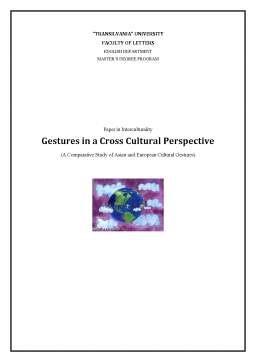Cuprins
- Introduction 3
- Common Asian Gestures 3
- Greeting Gestures 3
- Beckoning Gestures 4
- Proximity 4
- Other Gestures 5
- Some European Gestures 6
- Diversity in Gestures 6
- Greeting Gestures 7
- Proximity 8
- The Language of the Hands 9
- Other Gestures 10
- Conclusion 10
Extras din proiect
Introduction
“If a man be gracious and courteous to strangers, it shows he is a citizen of the world, and that his heart is no island cut off from other lands, but a continent that joins them.” - Sir Francis Bacon
As the global village continues to “shrink” and cultures collide, it is essential for all of us to become more sensitive, more aware, more observant to the myriad of gestures and body language that surround us. There are various cultures in the world with their unique customs and values, and their own distinctive language. This variety makes our world a splendid place. Imposing ones own cultural values and neglecting variety is not the right means of communication and the best way to establish relationship.
One may not have time to learn a language or languages but taking time to learn the signals makes one a powerful communicator. In order to learn the signals one has to know and understand the specific culture where the respective gesture is used. By combining the Asian and European cultures one can get a rich and colourful picture of various gestures people apply in these countries.
Some Common Asian Gestures
Greeting Gestures
When greeting Asians use handshaking and bowing, their precedence varies according to regions. The Chinese nod politely or bow slightly when greeting another person. A handshake is also acceptable, especially in formal situations or to show respect. Hugging and kissing when greeting are uncommon. A smile is preferred to a pat on the back or a similar gesture.
The graceful act of bowing is the traditional greeting in Japan. Many westerners view the bow as an act of subservience, but in Japan that would be completely wrong. For the Japanese a bow signals respect and humility, two qualities required throughout Asia. In Japanese, it is extremely important to know the rank of people with whom one comes into contact. The person of lower rank bows first and lowest. The lower the bow and the longer one holds the position, the stronger is the indication of respect, gratitude, sincerity, humility. When unsure of status, the safest move is to bow a shade less low than the other person. Among Koreans a younger or lower-status person always bows until the other offers a handshake or returns the bow. When Korean men shake hands, the right hand is extended, often supported at the wrist by the left hand to show deference, and the head is slightly bowed.
However, they have also adopted the western custom of shaking hands accompanied by a light grip and perhaps with eyes averted. The western custom of shaking hands is spreading rapidly in Taiwan and is now probably the customary form of greeting, but often a nod of the head is sufficient. Hugging and kissing when greeting are uncommon. Repeatedly blinking the eyes at someone is considered impolite. One gesture of special respect for the elderly is to cover one’s left fist with one’s right hand or place palms together, and raise both hands to the heart.
The Chinese are enthusiastic applauders, they often use it for greeting somebody. When a person is applauded in this fashion it is the custom for that person to return the applause or a "thank you."
Avoiding direct eye contact is essential here. It is considered rude to stare. Prolonged direct eye contact is taken as impolite or even intimidating.
Beckoning Gestures
To beckon someone, the palm faces downward and the fingers are moved in a scratching motion. One should avoid using the index finger, palm up and toward oneself, in a back forth curling motion toward ones body. That gesture is used only for animals and can be considered rude. The open hand (or the middle finger in Korea) is used for pointing. Using the feet to gesture or to move or touch other objects is avoidable because the feet are considered lowly and dirty. It is not advisable to point using the index finger, the open palm should be used instead.
Proximity
Asians are not touch oriented societies. They avoid public display of affection. On the other hand, people of the same sex may be seen walking hand-in-hand, which is simply a gesture of friendship, this holds especially true in China. Personal space is much less in China or in Japan therefore apologies are neither offered or expected when pushing and shoving in stores or when groups board public buses or trains. Pushing (bumping) in crowds is considered disrespectful and very rude. Queues are generally respected.
Preview document
Conținut arhivă zip
- Paper in Interculturality - Gestures in a Cross Cultural Perspective - A Comparative Study of Asian and European Cultural Gestures.doc



















